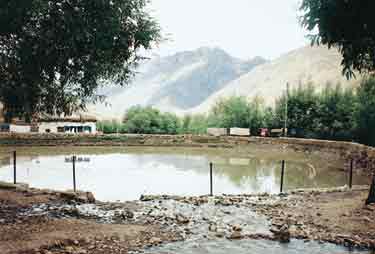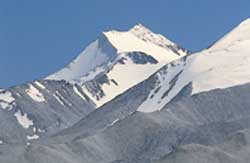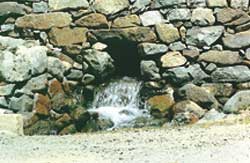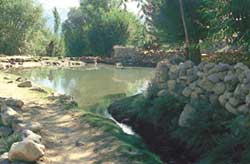 The
Spiti area of Himachal Pradesh (a province in India) is a cold desert but surprisingly,
agriculture is its mainstay. Spiti’s lunar-like terrain was transformed into an
agrarian success story by an ingenious system, devised centuries ago to tap distant
glaciers for water. But short-sighted developmental policies, though well-intentioned, now
threaten both this unique irrigation system and the social consciousness that spawned it. The
Spiti area of Himachal Pradesh (a province in India) is a cold desert but surprisingly,
agriculture is its mainstay. Spiti’s lunar-like terrain was transformed into an
agrarian success story by an ingenious system, devised centuries ago to tap distant
glaciers for water. But short-sighted developmental policies, though well-intentioned, now
threaten both this unique irrigation system and the social consciousness that spawned it.Spiti
is an important trading post on the route connecting Ladakh and the plains of Himachal
Pradesh. Villages in the Spiti subdivision are located between 3,000 m and 4,000 m, which
means they are snowbound six months a year. Rainfall is negligible in Spiti because it is
a rainshadow area. The soil is dry and lacks organic matter. But, despite these handicaps,
the Spiti valley has been made habitable and productive by human ingenuity.
But Spiti’s unique contribution to farming is kul irrigation, which
utilises kuls (diversion channels) to carry water from glacier to village. The kuls
often span long distances, running down precipitous mountain slopes and across crags and
crevices. Some kuls are 10 km long, and have existed for centuries.
The crucial portion of a kul is its head at the glacier, which is to be tapped.
The head must be kept free of debris, and so the kul is lined with stones to
prevent clogging and seepage. In the village, the kul leads to a circular tank from
which the flow of water can be regulated. For example, when there is need to irrigate,
water is let out of the tank in a trickle. Water from the kul is collected through
the night and released into the exit channel in the morning. By evening, the tank is
practically empty, and the exit is closed. This cycle is repeated daily. The kul system
succeeds because Spiti residents mutually cooperate and share. The culture also is
instrumental in maintaining the carrying capacity of the surrounding cultivable land.
However, this system, carefully nurtured through the centuries, now runs the risk of being
upset through government intervention.
 |
From glacier, |
 |
through kul, |
 |
to tank. |
Due to limited water availability, inheritance laws in Spiti traditionally seek to
prevent fragmentation of landholdings. The eldest son inherits not only the land, but also
the farm implements, the family house and the family’s water rights. His siblings
either serve in the common household or, more likely, become monks or nuns in Buddhist
monasteries. Thus, a sort of population control has been evolved, which serves to stave
off pressure on the landholdings.
Water rights are owned exclusively by members of the bada ghars (big
houses), who are descendants of the original settlers or founders of the village. This
system, besides establishing the pre-eminence of the bada ghars, has also installed
a local social hierarchy. The greater the share of a family’s water rights, the more
land it controls. In Kaza, for example, water rights over the single kul,
irrigating 32 ha, are shared by 18 bada ghars. Other families in Kaza have to buy
water from the bada ghars, and payment is generally made in kind or by providing
free labour, but often the water is given freely. Water transactions are based on trust
and are neither written down nor codified.
When a good snowfall assures abundant water, kul water is freely dispensed, but
when water is scarce, equality gives way to a preferential system. During a water
shortage, bada ghar members irrigate their fields first; others get water only
later in the season. This practise has the advantage of ensuring that the demand for
labour is spread over the entire harvest season because the bada ghar’s crops
ripen early, when other families are free to help in harvesting. This spacing of the need
for labour does away with demand peaking at the same time throughout the valley, and
provides a firm basis for community labour. These cooperative efforts also mean that time
and effort do not become areas of conflict between those who require labour and those
offering it.
Nevertheless, water distribution from kuls can create tension, for, when there
is a water shortage, the bada ghars in effect are in a dominant position and suffer
the least, unlike those with secondary access who have to await their turn, but are not
certain if their share will be adequate.
But even among bada ghars, the distribution of water shares may be unequal. The
factors that determine sharing among them are not clear, and probably were settled when
the kul was constructed. Padma Dorjea, a Kaza schoolteacher, says the family that
contributed the most in labour and other resources when the kul was constructed,
gets the largest share under water rights passed on through generations.
The unit of kul water is one day’s supply. Between sowing in April and
harvesting in September, water availability is for approximately 70 days. But if a family
whose share is 30 days need kul water for only 20 days, it can sell its surplus.
In Kibber, water is supplied by three kuls whose shares are owned jointly by 32 bada
ghars. The kuls, named Phil, Phizur and Shrik, together irrigate 73 ha of land.
Eighteen bada ghars use the waters of the Phil kul, whose supply is sufficient to
irrigate 4 ha daily. The 18 families using it are divided into two groups of nine families
each, and the water supply is alternated between the two groups on a daily basis. Water
from Shrik, the smallest of the three kuls, is shared by six bada ghars,
also divided into two groups. But the eight bada ghars that share the Phizur kul,
are divided into four groups, with each getting water just once every four days because
the kul’s capacity is limited. Other families in Kibber have to acquire water
from the 32 bada ghars.
Water shares are renewed and adjusted every season according to need, but a share
cannot be lent, sold or disposed of in perpetuity. This restriction preserves the position
of the bada ghar families.
Controlling rules
Over the past 15 years, however, the Union government has slowly made its
presence felt in the Spiti valley as a modernising agent, whose actions are profoundly
changing traditional production practises and social patterns. Its sponsorship of
facilities ranging from schools to hospitals has opened up a variety of government jobs
and agriculture is no longer the valley’s only source of sustenance and employment.
The irrigation department has taken control of the kuls and introduced a number
of technical and physical innovations. Kul heads, for example, have been reinforced
with cement or concrete and some of the kuls have been complemented with rubber
pipes. Old kuls have been repaired and renovated in this manner and new kuls
have been constructed.
These interventions, along with the increasing dominance of a market economy, a rise in
labour mobility, and the availability of alternative sources of employment, have doomed
traditional social mechanisms for the repair and maintenance of kuls.
Traditionally, community labour was used to repair kuls and each household
contributed either in labour or in kind to keep the kuls in good condition. But
residents of Kibber, Losar and Sagnam villages complain that the irrigation
department’s intervention and the lack of labour arising from increased alternative
job opportunities have resulted in the breakdown of the traditional system.
Furthermore, the government’s stipulation that kul water must be
distributed equally is jeopardising the valley’s traditional social order, and the bada
ghars face the loss of both control over water and their position in the village
hierarchy. However, the disbanding of the traditional hierarchies does not automatically
result in egalitarianism because the emerging social order is based on market forces and
money power. This means that access to kul water will no longer be based on
availability and need, and monetisation of this resource will leave many of Spiti’s
families impoverished. |





 The
Spiti area of Himachal Pradesh (a province in India) is a cold desert but surprisingly,
agriculture is its mainstay. Spiti’s lunar-like terrain was transformed into an
agrarian success story by an ingenious system, devised centuries ago to tap distant
glaciers for water. But short-sighted developmental policies, though well-intentioned, now
threaten both this unique irrigation system and the social consciousness that spawned it.
The
Spiti area of Himachal Pradesh (a province in India) is a cold desert but surprisingly,
agriculture is its mainstay. Spiti’s lunar-like terrain was transformed into an
agrarian success story by an ingenious system, devised centuries ago to tap distant
glaciers for water. But short-sighted developmental policies, though well-intentioned, now
threaten both this unique irrigation system and the social consciousness that spawned it.


